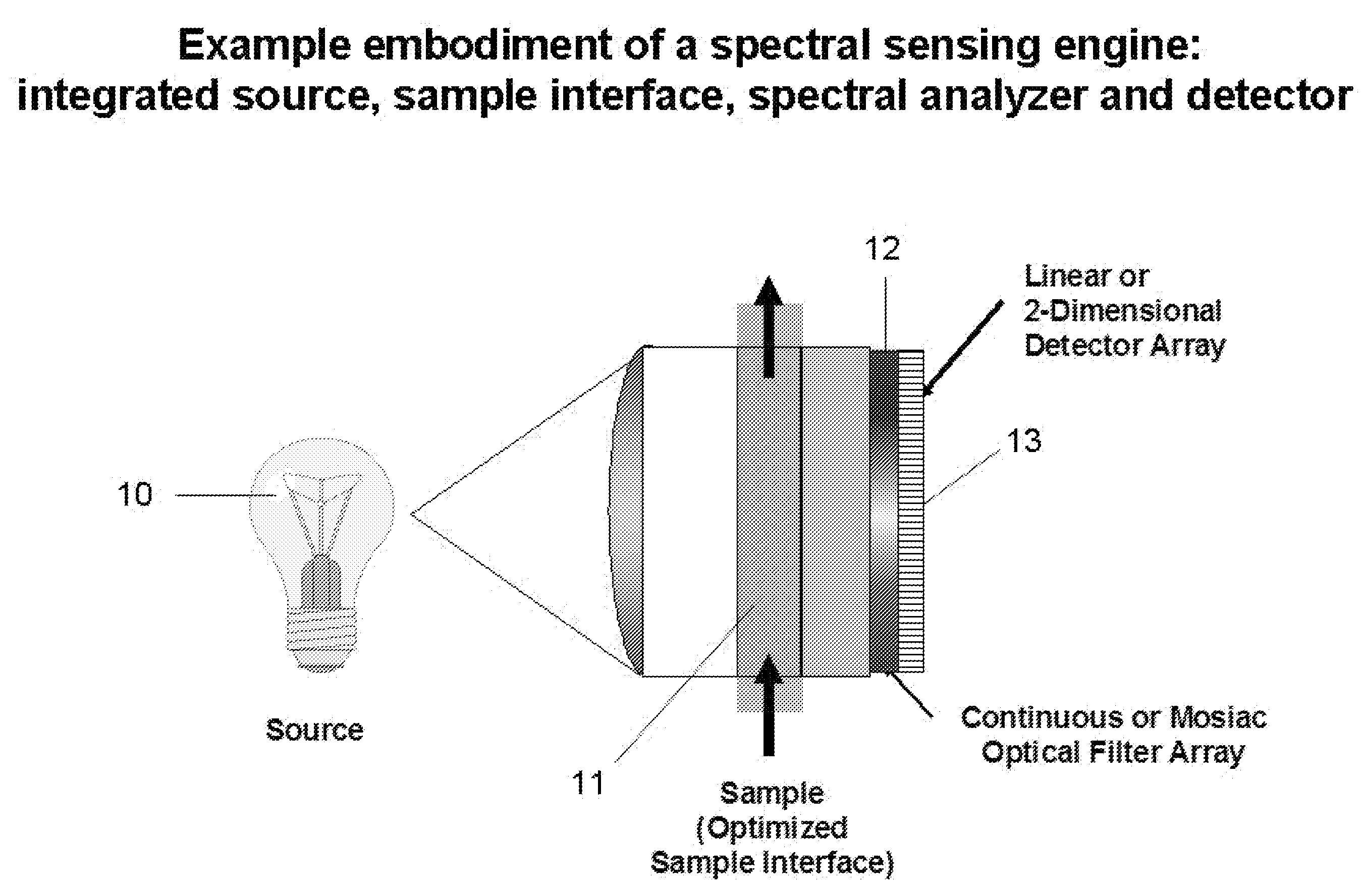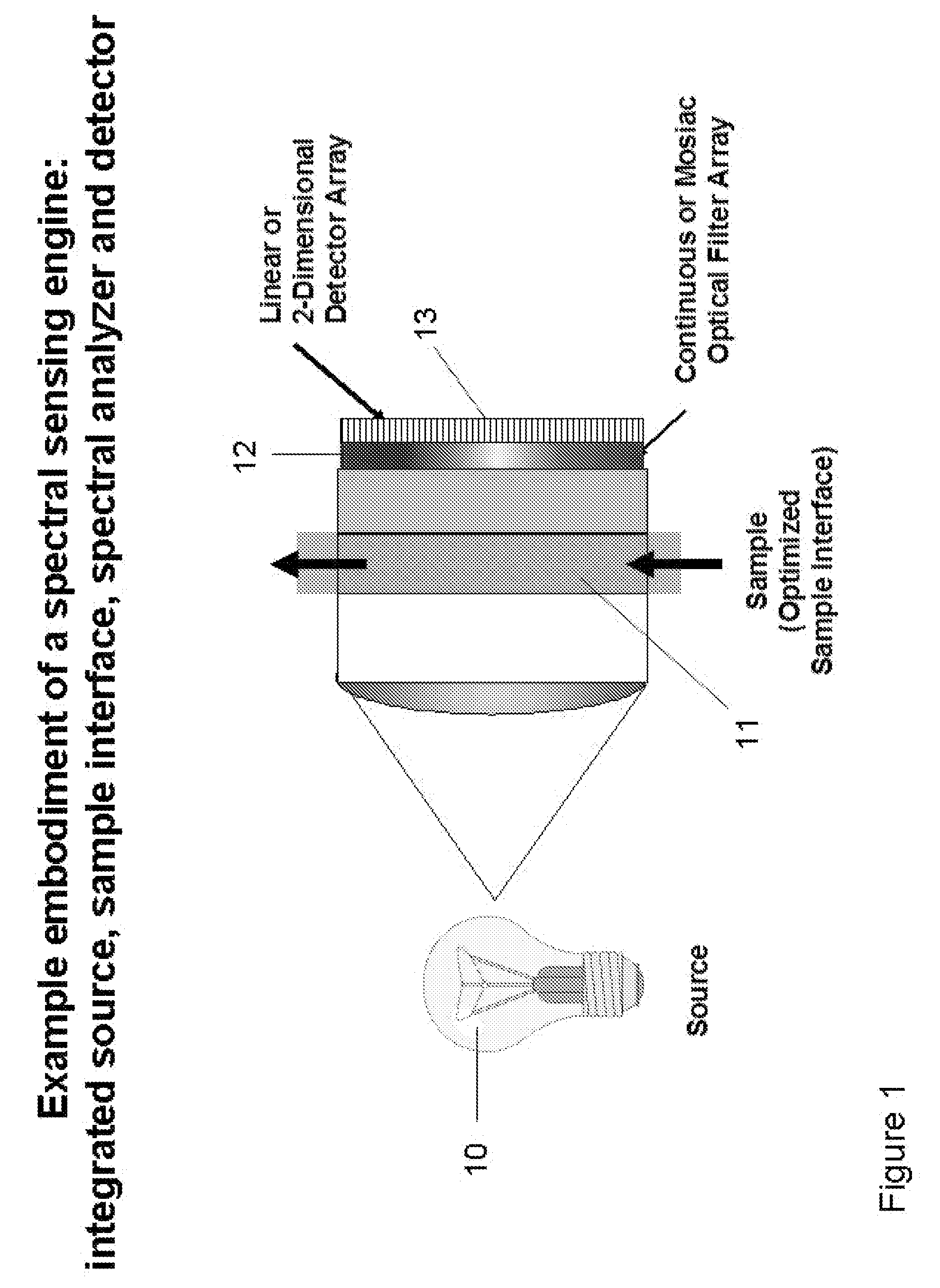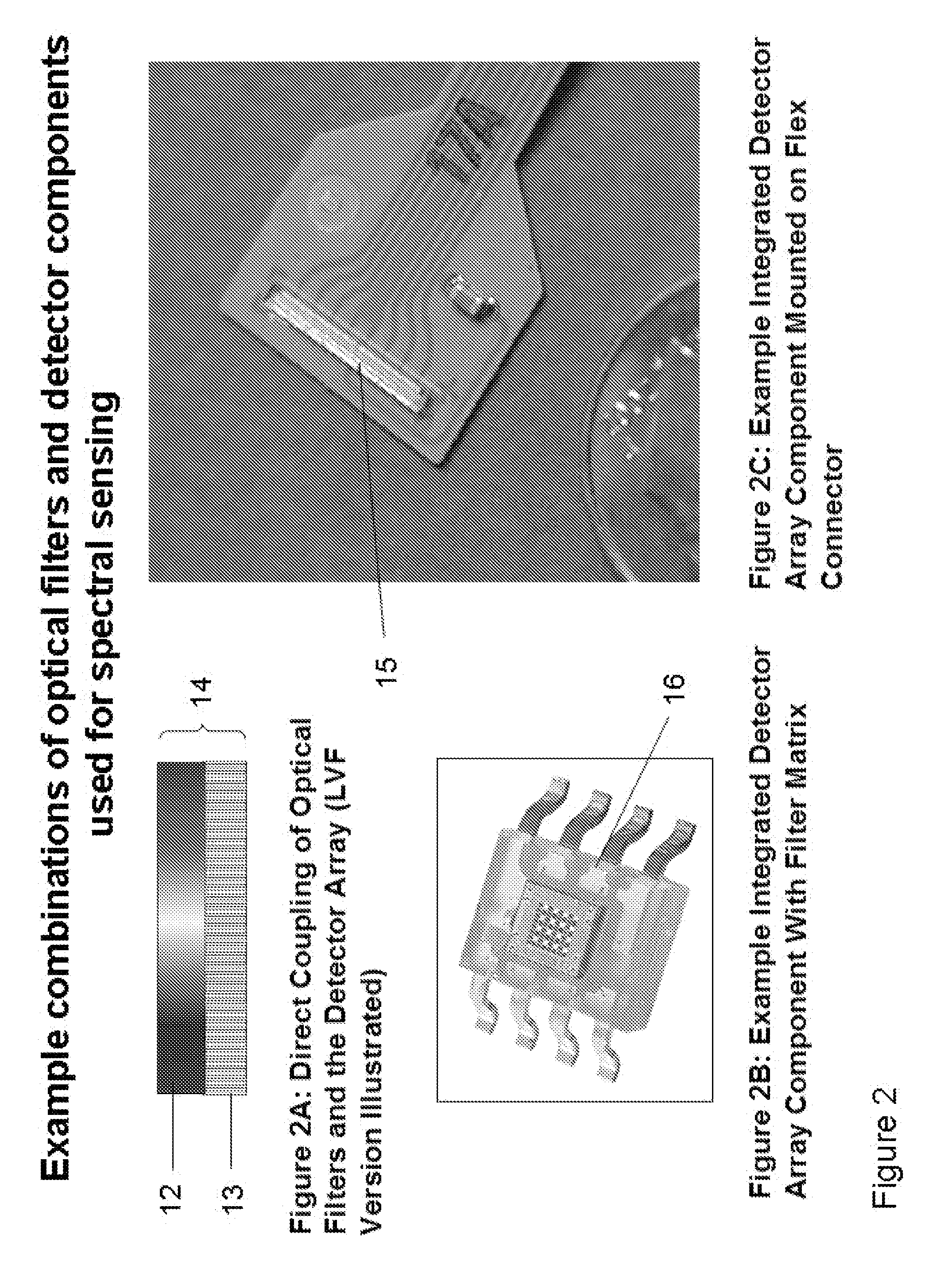[0008]The present invention uses a miniaturized, low cost spectral sensing device, a major advancement in measurement opportunity over the status quo, and overcomes issues related to size or space occupied in the laboratory, or the size of a portable
spectrometer. Each device is intended to provide the functionality of a normal
spectrometer or spectral analyzer, but at reduced cost, and with a significantly
reduced size for the total
package.
[0013]In its
standard form the fluid is drawn into the measurement region of the sensing device, as noted, via an integrated pump or suction device. The measurement region is a removable component, defined as a sampler, and is implemented in the form of a modified
pipette-like structure, where the fluid is drawn in through a tip. The sampler measurement chamber includes reflective elements encapsulated and / or retained within the construction. These reflective elements capture the light / energy emerging from the source mounted within the optical interface of the spectral engine. This light / energy is then returned, in a retro-reflective manner back to the spectral sensing element (
detector), which is also mounted within the optical interface of the spectral engine. In this mode of operation, the light / energy passes through the fluid at least three times; twice to and from the spectral engine and once between the two reflective elements. This produces a composite dimension, which is known as the pathlength. This is equivalent to a
single pass through a conventional
liquid cell. These dimensions can be set to be equivalent to normal pathlengths used in conventional cells, and these will be nominally from 1.0 mm to 10.0 cm (total distance). It is expected that in the standard format, this measurement chamber will be constructed from an optically transparent medium, and for most applications, this will be a clear plastic material. The latter is to be constructed as a molded part in the most common implementation of the device. The total sampler construction can be produced in two or more parts, with the inner measurement area being encased within a black and / or optically opaque external shell. In the common implementation this can be made as a co-extruded part, or as an
assembly made from two or more separate molded parts. Note that the optically opaque exterior of the sampler will make a positive light seal with the outer casing of the main measurement
system. In this manner, the measurement area is shielded from external light sources, thereby ensuring accurate photometry, and also enabling low-light measurements, such as
fluorescence and
luminescence.
[0014]In the standard mode of operation it is assumed that the fluid being measured will already contain an active
chromophore (light absorbing entity related to the
analyte) or
fluorophore (light emitting entity related to the
analyte). This
chromophore /
fluorophore will either be native to the material being measured or induced by the use of one or more specific reagents. The mixing of reagents to form a measurable solution is a standard practice in most testing laboratories, and it is also a
standard procedure for most field-based testing. The micro-spectral
sensing system described in this
package has the
advantage that the swept volume required for the fluid by the measurement
system is in the region of a few hundred microliters to a few milliliters. This reduces significantly the overhead for reagents, and it also reduces the environmental
impact for disposal of the fluid after analysis. This provides an additional
advantage insofar as it makes some measurements practical that would be otherwise too expensive to perform because of the high intrinsic cost of the
reagent. Examples of such measurements exist in the
biotechnology and
medical testing areas.
[0015]In an attempt to make the interaction of reagents with the fluid under study more efficient, in terms of ease-of-use, removing the need for mixing vessels, reducing
exposure to reagents, and significant cost reductions for expensive reagents, Smart Tips™ or Smart Samplers™ are used. Smart Tips / Samplers are designed to enable
reagent interaction and mixing to be carried out in situ, without the need for external reagents or mixing vessels. The internal architecture of the tip or sampler includes molded features that generate turbulences when the fluid is drawn into the tip. Just sufficient
reagent (or reagents) to fulfill the requirement of the analysis can be located in an immobilized form (encapsulated in a water /
solvent soluble
solid medium or a hydrophilic medium) adjacent to the entrance of the tip. The medium and the reagent can dissolve in the sample or interact with the sample as it enters the tip or sampler, and the consequent solution can be agitated during its passage into the measurement region. An option in the design is to key the fitting of the tip to the body of the measurement system in a way that the specific analysis can be automatically defined within the
measurement device. This can be accomplished either by a physical key, or via electronic means, such as a bar code, a digital bar code, or by a technology such as RFID. In the case of the digital bar coding, this can be implemented by the use of an additional, well-defined
chromophore /
fluorophore (non-interfering) mixed in with the reagent.
[0018]The
standard methods of analysis that are referenced in
paragraph [016] normally involve some form of formula for the calculation of the final results. The formula often contains numerical relationships and coefficients that are applied to the
raw data and these are determined by running predefined calibration standards. The system as described can be used to develop this type of calibration. The calibration can be carried out within a controlled environment, and with a live connection to a PC or
laptop computer for data
logging and storage. The
calibration set can then be handled by an established procedure, such as a Beer-Lambert based calculation of light /
energy absorption versus concentration relationship. The coefficient(s) and intercept can be downloaded into the measurement system along with measurement settings and criteria. Complex applications can require multivariate modeling, and in such cases the modeling equations can be downloaded. The architecture of the onboard
microprocessor can be sufficiently flexible to accommodate such downloads, and can accommodate
multiple models / calibrations, dependent on the size of the calibration data, and the available onboard memory storage. This enables an end-user to customize the measurement system for a broad range of applications. The system is not limited by design to fixed analyses. Individual methods stored in the measurement system can be recalled at anytime, by a
user interface linked to the display on the front of the unit.
 Login to View More
Login to View More  Login to View More
Login to View More 


